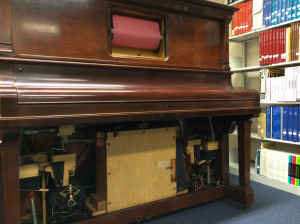
(ALEXANDRA NGUYEN-PHUC/The Stanford Daily)
Jerry L. McBride, the head librarian of the music department, had heard renditions of French composer Camille Saint-Saen’s “The Swan” before, but never a version played by the composer himself.
“Lots of times you hear ‘The Swan’ [from Carnival of the Animals] being played and it’s very sentimental,” McBride said. “Saint-Saens plays it in a way that it sounds sort of heroic.”
Stanford’s Music Library recently acquired the Denis Condon Collection of self-playing pianos and more than 7,500 music rolls, some of which are recordings of late 19th-, early 20th-century composers playing their own music.
Members of the Department of Music are collaborating with non-Stanford specialists to restore the reproducing pianos and digitalize rolls through an initiative called The Player Piano Project.
Kumaran Arul, lecturer in the music department whose research specializes in 20th-century performance, said that this project is a goldmine of insight into historic styles.
“[Rolls were] essentially the beginning of the creation of the recording as an artwork. The recording itself becomes the musical product,” Arul said. “Prior to this, you could say it was only during the live performance that you could have music.”
The 10 reproducing pianos in the collection decipher notes by reading a series of holes punctured in the paper rolls and control the pressure applied to every key through a complex system of air tubes.
While acoustic recording mediums, such as wax cylinders and early disks, existed at that time, they had flaws such as scratchy sound and poor depth perception. Rolls could record 15 to 30 minutes of audio, while disks only allowed two to four minutes per side.
“When I listened to the roll and the acoustic recordings, the roll made the [pianist] sound more like what I’ve read and how I’ve understood them to play,” Arul said. “They were able to be more themselves in this medium as opposed to the acoustic medium.”
Some of the oldest recorded artists chose to use only rolls rather than acoustic techniques, so the acquisition of these rolls allows researchers to delve into unknown territories. Arul cited pianist Carl Reinecke, who was born in 1824, as such an example.
“Without [Reinecke’s] roll recordings, we’d have no sense of what he actually sounded like,” Arul said. “He was a very controversial and very important player and his style was hotly debated at the time by people like Wagner and Liszt. So when you trace the style, it’s critical evidence as to what was happening in the 19th century.”
Rolls of Reinecke’s playing revealed rhythmic irregularity and unusual variations of what was written on the score. Experts dismissed the rolls as damaged because the music contained very different accents and idioms.
“What scholars are finding out right now is that the performance traditions that we had from the 19th century have been lost in the late 20th century and 21st,” McBride said. “Even though most classical music pianists are still playing music from the 19th century, they’re not playing them the same way that people from the 19th century did.”
According to Arul, listening to old rolls sheds light on how classical pianists have been trained in the 21st century. This research is possibly the beginning of a movement to revive old performance practices that are only now being rediscovered.
“This in a sense is suggesting that we re-examine what we have made classical music into today,” Arul said.
“Some of what this suggests is that [classical music] might need shaking up,” he added.
The Player Piano Project is continuing to evolve as the Department of Music plans to partner with various engineering and computer science departments to design a new digital scanner dedicated to making optical images of the rolls. McBride hopes that the original rolls will be archived in the music library while the audio files will be available online for a wide audience.
Additionally, a reproducing piano will be featured in a concert with the Stanford Symphony Orchestra at Bing Concert Hall in spring 2015.
“I would urge people to come and hear the pianos when we do have concerts of them,” McBride said. “A recording is only a pale representation of what [a piece] really sounds like; there’s nothing that really compares to hearing the pianos play the rolls.”
Contact Alexandra Mai-Phuong Nguyen-Phuc at amn17 ‘at’ stanford.edu.
